Abstract
In any manufacturing setup, reaming operation is always prominent and present because of ever increasing demands for improved quality of the manufactured products. At the same time, new engineering materials make the process challenging. Further, reaming is the highly sought-after operation to achieve specified tolerance for specified applications to satisfy the rising demand for high-quality and precision-engineered products. Hence, accurate prediction of reaming torque is of utmost necessity, as it gives rise to uneven cutting forces, thereby affecting the surface finish of the reamed hole. High torque produces high-cutting forces, resulting in uneven surface finish and oversized holes. In this regard, the ability of traditional statistical tools to identify intricate correlations and patterns in reaming operation data is limited. To overcome these issues, machine learning methods such as the Artificial Neural Network (ANN) provide reliable options. The present study compares the use of ANN and Random Forest to analyze the data from reaming operations to predict the torque and compares it with those of the Random Forest method and the polynomial regression model. The model is trained and tested using a well-structured dataset that includes multiple input parameters (e.g., material, tool radius, and rotation angle) and the related reaming outputs (e.g., torque) in the suggested supervised learning method. An interconnected single layer of artificial neurons is used to create the ANN model. A comparison is made between the ANN and the Random Forest algorithm, a well-liked ensemble learning technique based on decision trees, to assess the performance of the ANN. The same dataset is used to train both ANN and Random Forest algorithms. The result showed that ANN gave better performance when compared to the other models, with testing accuracy of 94.4% and 61% for ANN and Random Forest, respectively.
1. Introduction
In the ever-evolving landscape of manufacturing engineering, a powerful force has emerged, reshaping the very foundation of this discipline. Recent advancements in the application of machine learning have unlocked a world of untapped potential, revolutionizing the way manufacturing processes are designed, optimized, and controlled. With the convergence of data-driven insights, intelligent algorithms, and cutting-edge technologies, machine learning has become the driving force behind the next industrial revolution, propelling manufacturing engineering into a new era of unprecedented efficiency, innovation, and competitiveness. A manufacturing environment where every operation is finely tuned, meticulously orchestrated, and continuously optimized is possible in the future. This vision is rapidly transforming into a reality due to the transformative power of machine learning. By harnessing vast amounts of data generated from sensors, equipment, and production lines, machine learning algorithms can unearth invaluable patterns, correlations, and insights once buried within the depths of complex manufacturing systems. These algorithms act as a virtual brain, processing and interpreting this data to drive intelligent decision-making, enabling manufacturers to optimize processes, streamline operations, and enhance overall productivity [1,2].
One of the most profound applications of machine learning in manufacturing engineering lies in predictive maintenance. Traditional maintenance practices often follow fixed schedules or reactive approaches, leading to unexpected breakdowns, costly downtime, and inefficiencies. However, with the integration of machine learning, manufacturers can now employ proactive strategies that leverage real-time data from sensors, historical records, and machine behavior analysis [3,4,5]. By continuously monitoring equipment performance, detecting anomalies, and predicting potential failures, machine learning algorithms empower manufacturers to implement timely maintenance actions, minimize unplanned downtime, and maximize the lifespan of critical assets, ultimately reducing costs and enhancing overall operational effectiveness [4].
Furthermore, machine learning has brought forth a paradigm shift in process optimization. Manufacturers can fine-tune parameters, improve yields, and optimize energy consumption by leveraging advanced algorithms and optimization techniques. These algorithms can explore vast solution spaces, seeking the most efficient combinations of variables and constraints. Through iterative learning and adaptation, machine learning algorithms continually refine their models, pushing the boundaries of manufacturing efficiency to new heights. Whether it be optimizing production schedules, reducing waste, or enhancing product quality, machine learning plays a pivotal role in achieving the highest levels of efficiency and competitiveness [6,7,8].
In the realm of machining, where precision and efficiency are paramount, recent advancements have ushered in a new era of possibilities by applying machine learning. Specifically, the domains of reaming operations have witnessed a transformative shift, as the marriage between cutting-edge technologies and age-old practices has opened doors to unprecedented levels of optimization and performance. Machine learning has become the guiding light in revolutionizing reaming operations through the assimilation of vast datasets, the harnessing of computational power, and the ingenuity of algorithms [9]. In a world where every stroke of a turn of a reamer is orchestrated with meticulous accuracy, eliminating errors thereby minimizing waste, will be possible in the future. This visionary landscape is becoming a reality through the infusion of machine learning into these manufacturing processes. By drawing insights from historical data, including tool wear, work piece characteristics, and operating parameters, machine learning algorithms can decipher complex patterns and develop predictive models that optimize reaming operations [10,11].
One of the significant breakthroughs lies in the realm of predictive maintenance, where machine learning algorithms can proactively identify signs of tool wear and potential failures. By continuously monitoring and analyzing sensor data, such as vibrations, temperatures, and cutting forces, these algorithms can accurately forecast the lifespan of tools, enabling manufacturers to schedule maintenance activities pre-emptively and avoid costly downtimes. This predictive prowess breathes new life into the manufacturing industry, fostering a proactive approach, reducing unplanned disruptions, and optimizing resource utilization [12,13,14].
Furthermore, machine learning algorithms have transcended the boundaries of traditional rule-based control systems by unveiling their potential for adaptive control in broaching and reaming operations. By leveraging real-time feedback from sensors and actuators, these algorithms dynamically adjust cutting parameters, tool paths, and feed rates, ensuring optimal performance despite varying workpiece properties and environmental conditions. Machine learning systems’ adaptability and self-learning capabilities enable them to continually refine their models, leading to enhanced precision, reduced cycle times, and improved surface finishes [15]. Additionally, collaborative robots, or cobots, have become indispensable assets in the manufacturing landscape, and machine learning has played a pivotal role in empowering these machines to interact seamlessly with human operators during broaching and reaming operations [16]. By training algorithms to recognize human gestures, speech commands, and movements, cobots can collaborate efficiently with their human counterparts, assisting in intricate tasks and ensuring a safe working environment. This symbiotic relationship between humans and machines amplifies productivity and paves the way for safer and more ergonomic workplaces [17].
The fusion of machine learning and reaming operations has ushered in a new chapter of possibilities in the manufacturing industry. With the ability to predict tool wear, enable adaptive control, and facilitate human–machine collaboration, machine learning has become the catalyst for unlocking unparalleled precision, efficiency, and innovation. As these advancements continue to unfold, one can stand to witness a future where every cut and stroke becomes an embodiment of perfection, transforming the very fabric of machining as we know it [18,19,20].
2. Materials and Methods/Methodology
The machining data is collected during the reaming operation conducted on the CNC machine for different materials: mild steel(MS), cast iron (CI), and aluminum(Al). The data was acquired at several intervals of rotation and a certain depth with the help of the sensors attached to the reaming tool. It was repeated for all three materials subjected to machining using a reaming tool of three different radii. Torque data was recorded for all the machining trials for further evaluation of the results as it directly impacts the roughness of the reamed surface. In other words, the huge variation in the cutting force will lead to unbalanced forces on the material or the machined surface leading to the improper surface finish.
The data set was plotted collectively for all materials in Figure 1 and individually with respect to tool radius to analyze the pattern in Figure 2, Figure 3 and Figure 4. The data has highly non-linear behavior and could not fit into any of the poly-fit curves because of the considerable scatter of the data pertaining to the angle of rotation of the reaming tool. In the initial levels of the angle of rotation of the reamer, the data has clusters, whereas in the higher levels of the angle of rotation, the data scatter is too high. Statistical tools will not give accurate results or a quality fit, i.e., the R2 value will be low, whereas ML tools provide the best fit and a good R2 value. Hence, the obtained data was analyzed using ANN and Random Forest algorithm.
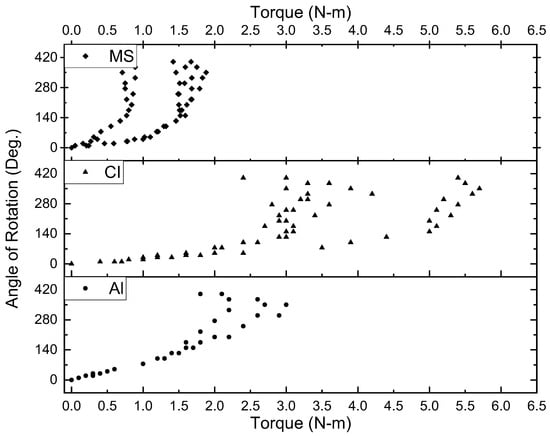
Figure 1.
Torque values of Al, MS, and CI material.
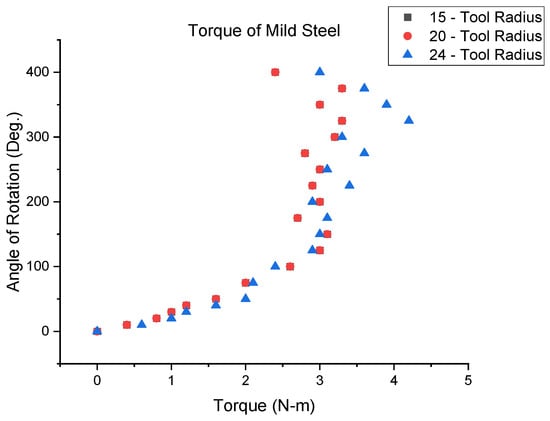
Figure 2.
Torque values of MS material for tool radius of 15, 20, and 24 mm.
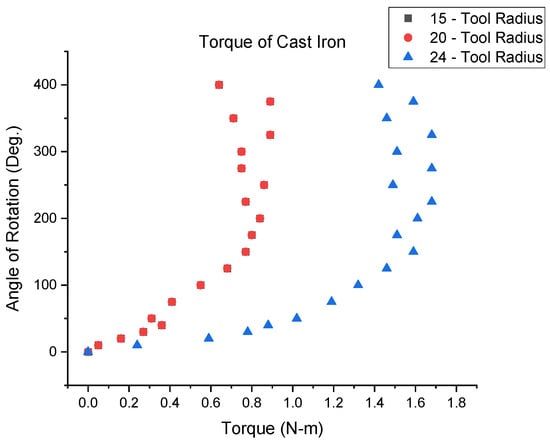
Figure 3.
Torque values of CI material for tool radius of 15, 20, and 24 mm.
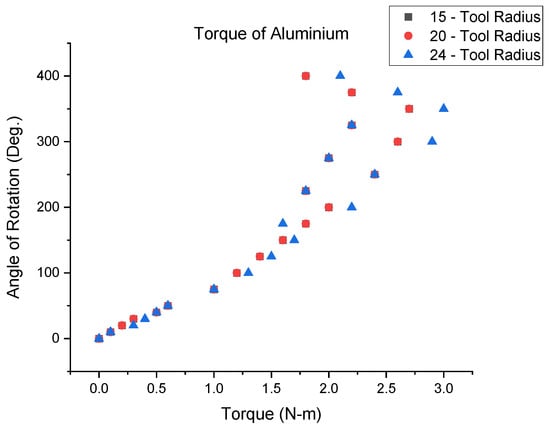
Figure 4.
Torque values of Al material for tool radius of 15, 20, and 24 mm.
The data of all the materials was grouped, and those materials were normalized as 0, 0.5, and 1 for Al, MS, and CI, respectively, and the whole data was normalized as per each attribute. This is done as per the “One-Hot encoding” method, where the materials are represented either by “binary code,” material 1 being 1 and the rest being 0 (Material 1—1 0 0; Material 2—0 1 0; Material 3—0 0 1) or it can have an “Ordinal relationship” by giving the material with a unique value for each of the material (Material 1—0; Material 2—0.5; Material 3—1). In this study, the results were computed using an ordinal relationship as it has given better results with trial experiments. The data has three input attributes (material, tool radii, and angle of rotation) and one output (torque) attribute.
Figure 5 describes the flow chart of building the ANN model. The data were randomly divided into training and testing data as 80% training data and 20% testing data. The model used to train the data was the “Feed Forward Neural Network.” This model was used as it can handle both linear and highly non-linear relationships between input and output data. It is also scalable, handling large data sets and complex models. The optimum number of neurons calculated for the hidden layer is 16.
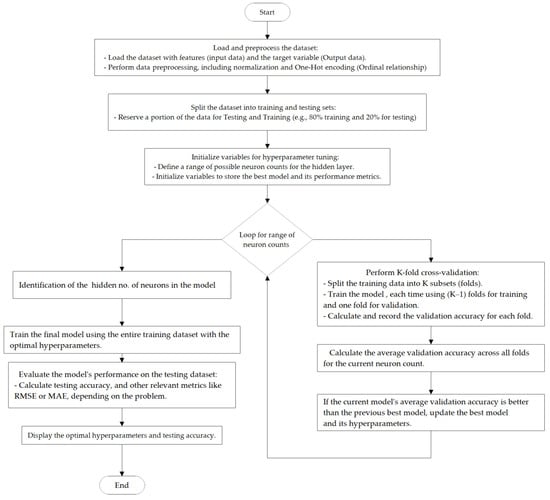
Figure 5.
Methodology of building the Neural Network model.
The ANN model selected is 3-16-1 (No. Input Layer—No. Hidden Layer—No. Output Layer). The data was then fed into the ANN program and analyzed for K-10 cross-fold validation to check the accuracy. In K-10 cross-fold validation, data was randomly split into 10 groups, then the (k − 1) set was used for training and one test for testing. The same would be looped 10 times by taking the next group for testing and recording the accuracy of the model. The hyperparameters used in the ANN and Random Forest model are in Table 1; the model was evaluated using testing accuracy and RMS values.

Table 1.
Hyper parameters of the ANN and Random Forest model.
3. Results and Discussion
3.1. Results
The experimental data was given as input to the developed ANN model, the Random Forest (Regressor model), and the Poly-Regressor model. In the case of ANN, the training accuracy obtained is 100% with a 5% deviation from the original data, and the testing data accuracy is around 94.44% with a mean square of 0.000483. The model is optimized for 16 no. of neurons. On the other hand, for the Random Forest model (Regressor Model) the training accuracy is 61.96%, and for the Poly-Regressor model, 19%. The reason is the too-low training data, making it not feasible to test the model. The testing accuracy of various machine learning models used in the study is shown in Table 2.

Table 2.
Testing accuracy of various machine learning models.
3.2. Discussion
Table 2 indicates that ANN provided 94.44% testing accuracy as it works on updating the weights. In contrast, in Random Forest, the data is initially classified accordingly and reaches a root node, and then takes the average of the output feature of the data set available in that leaf node, which has been identified as the cause for the decrease in the model testing accuracy. The polynomial regressor model is the best curve fit for the data as the data scatter is too high for the data related to the rotation angle; hence, the model’s accuracy is too low.
The results obtained from the ANN model in the present study are much better while predicting the reaming torque when compared to the Random forest (Regression model) and Polynomial Regression model. Hence, ANN predictions will be more reliable in predicting torque produced during the reaming process based on the inputs, material, tool radius, and rotation angle.
4. Conclusions
The results have shown that the ANN model will yield better results and successful extraction of reaming characters of the process while analyzing the torque during the reaming operation with 94.44% accuracy. The developed ANN model can monitor the torque, resulting in a better finish to reamed surfaces. Based on the study’s results, it can be concluded that the ANN algorithm yielded better results than the Random Forest algorithm while predicting the torque during the reaming operations. The prediction accuracy of the ANN model improved by 32.48% when compared to the Random Forest (Regressor model) whereas it improved by 74.57% when compared with the polynomial regressor model. The torque data can be further coupled with the machine’s current consumption to better control the machining to obtain the required surface finish. However, this paperwork is limited to predicting the torque in the reaming process only; however, the same methodology can be extended for other machining processes, which the authors intend to take as future work.
Author Contributions
Conceptualization, M.C.R. and G.S.V.; methodology, M.C.R.; software, M.C.R.; validation, M.C.R.; formal analysis, R.C.K. and G.S.V.; resources, R.C.K.; writing—original draft preparation, M.C.R.; writing—review and editing, R.C.K.; visualization, G.S.V.; supervision, R.C.K.; and project administration, R.C.K. All authors have read and agreed to the published version of the manuscript.
Funding
This research received no external funding.
Institutional Review Board Statement
Not applicable.
Informed Consent Statement
Not applicable.
Data Availability Statement
The data can be obtained from the corresponding author on request.
Conflicts of Interest
The authors declare no conflict of interest.
References
- Rom, M.; Brockmann, M.; Herty, M.; Iacomini, E. Machine learning tools in production engineering. Int. J. Adv. Manuf. Technol. 2022, 121, 4793–4804. [Google Scholar] [CrossRef]
- Isaac, A.O.; Jantan, A.; Omolara, E.A.; Dada, V.K.; Mohamed, A.N.; Arshad, H. State-of-the-art in artificial neural network applications: A survey. Heliyon 2018, 4, e00938. [Google Scholar] [CrossRef]
- Serin, G.; Sener, B.; Ozbayoglu, A.M.; Unver, H.O. Review of tool condition monitoring in machining and opportunities for deep learning. Int. J. Adv. Manuf. Technol. 2020, 109, 953–974. [Google Scholar] [CrossRef]
- Schorr, S.; Möller, M.; Heib, J.; Bähre, D. Quality prediction of drilled and reamed bores based on torque measurements and the machine learning method of random forest. Procedia Manuf. 2020, 48, 894–901. [Google Scholar] [CrossRef]
- Naik, N.; Bhat, R.; Shivamurthy, B.; Shetty, R.; Parashar, P.R.; Hegde, A.L. Statistical and artificial neural network coupled technique for prediction of Tribo-performance in amine-cured bio-based epoxy/MMT nanocomposites. J. Compos. Sci. 2023, 7, 372. [Google Scholar] [CrossRef]
- Schorr, S.; Möller, M.; Heib, J.; Bähre, D. In-process quality control of drilled and reamed bores using NC internal signals and machine learning method. Procedia CIRP 2020, 93, 1328–1333. [Google Scholar] [CrossRef]
- Schorr, S.; Möller, M.; Heib, J.; Bähre, D. Comparison of machine learning methods for quality prediction of drilled and reamed bores based on NC-internal signals. Procedia CIRP 2021, 101, 77–80. [Google Scholar] [CrossRef]
- Tan, T.; Zhang, H. A risk prediction method of pipe sticking accidents due to wellbore uncleanness for long horizontal section wells. J. Pet. Sci. Eng. 2022, 210, 110023. [Google Scholar] [CrossRef]
- Luíza da Costa, N.; Dias de Lima, M.; Barbosa, R. Evaluation of feature selection methods based on artificial neural network weights. Expert Syst. Appl. 2021, 168, 114312. [Google Scholar] [CrossRef]
- Jamwal, A.; Agrawal, R.; Sharma, M.; Dangayach, G.S.; Gupta, S. Application of optimization techniques in metal cutting operations: A bibliometric analysis. Mater. Today Proc. 2021, 38, 365–370. [Google Scholar] [CrossRef]
- Fischer, A. Garson’s method trumps Olden’s method in every case—How to determine relative importance of input-variables in nonlinear regression with artificial neural networks. Ecol. Modell. 2015, 309–310, 60–63. [Google Scholar] [CrossRef]
- Shang, G.; Xu, L.; Tian, J.; Cai, D.; Xu, Z. A real-time green construction optimization strategy for engineering vessels considering fuel consumption and productivity: A case study on a cutter suction dredger. Energy 2023, 274, 127326. [Google Scholar] [CrossRef]
- Klein, S.; Schorr, S.; Bähre, D. Quality prediction of honed bores with machine learning based on machining and quality data to improve the honing process control. Procedia CIRP 2020, 1322–1327. [Google Scholar] [CrossRef]
- du Preez, A.; Oosthuizen, G.A. Machine learning in cutting processes as enabler for smart sustainable manufacturing. Procedia Manuf. 2019, 810–817. [Google Scholar] [CrossRef]
- Fratila, D.; Caizar, C. Application of Taguchi method to selection of optimal lubrication and cutting conditions in face milling of AlMg3. J. Clean. Prod. 2011, 19, 640–645. [Google Scholar] [CrossRef]
- Shi, D.; Gindy, N.N. Tool wear predictive model based on least squares support vector machines. Mech. Syst. Signal Process. 2007, 21, 1799–1814. [Google Scholar] [CrossRef]
- Axinte, D.A. Approach into the use of probabilistic neural networks for automated classification of tool malfunctions in broaching. Int. J. Mach. Tools Manuf. 2006, 46, 1445–1448. [Google Scholar] [CrossRef]
- Mo, S.P.; Axinte, D.A.; Hyde, T.H.; Gindy, N.N.Z. An example of selection of the cutting conditions in broaching of heat-resistant alloys based on cutting forces, surface roughness and tool wear. J. Mater. Process. Technol. 2005, 160, 382–389. [Google Scholar] [CrossRef]
- Bonnardel, Q.; Wagner, V.; Dessein, G.; Dutilh, V.; Mandrile, S. Effects of Cutting Parameters over Turning of UDIMET®® 720 Superalloy in a Broaching Process Simulation. Procedia CIRP 2017, 572–577. [Google Scholar] [CrossRef]
- Singh, H.; Singh, K.; Vardhan, S.; Sharma, S.M. A Critical Review of Mechanical and Wear Resistance Characterizations on Developed Aluminium Matrix Composite Reinforced With MgO Particulates. J. Comput. Mech. Manag. 2023, 2, 45–56. [Google Scholar] [CrossRef]
Disclaimer/Publisher’s Note: The statements, opinions and data contained in all publications are solely those of the individual author(s) and contributor(s) and not of MDPI and/or the editor(s). MDPI and/or the editor(s) disclaim responsibility for any injury to people or property resulting from any ideas, methods, instructions or products referred to in the content. |
© 2023 by the authors. Licensee MDPI, Basel, Switzerland. This article is an open access article distributed under the terms and conditions of the Creative Commons Attribution (CC BY) license (https://creativecommons.org/licenses/by/4.0/).